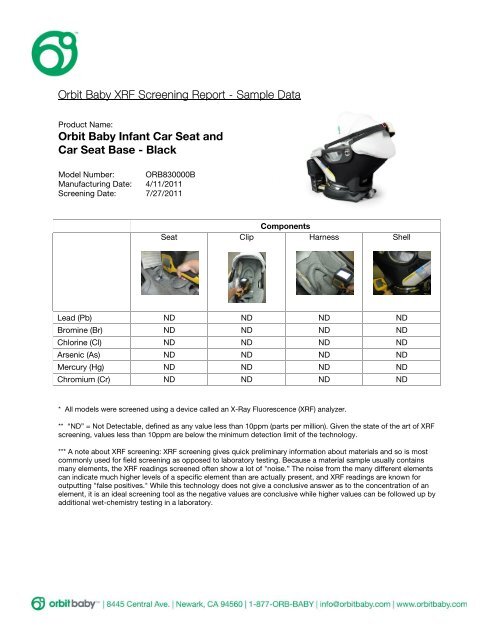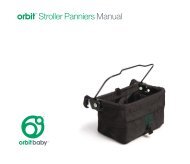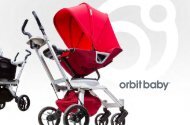Orbit Baby XRF Screening Report - Sample Data Orbit Baby Infant ...
Orbit Baby XRF Screening Report - Sample Data Orbit Baby Infant ...
Orbit Baby XRF Screening Report - Sample Data Orbit Baby Infant ...
You also want an ePaper? Increase the reach of your titles
YUMPU automatically turns print PDFs into web optimized ePapers that Google loves.
<strong>Orbit</strong> <strong>Baby</strong> <strong>XRF</strong> <strong>Screening</strong> <strong>Report</strong> - <strong>Sample</strong> <strong>Data</strong><br />
Product Name:<br />
<strong>Orbit</strong> <strong>Baby</strong> <strong>Infant</strong> Car Seat and<br />
Car Seat Base - Black<br />
Model Number: ORB830000B<br />
Manufacturing Date: 4/11/2011<br />
<strong>Screening</strong> Date: 7/27/2011<br />
Components<br />
Seat Clip Harness Shell<br />
Lead (Pb) ND ND ND ND<br />
Bromine (Br) ND ND ND ND<br />
Chlorine (Cl) ND ND ND ND<br />
Arsenic (As) ND ND ND ND<br />
Mercury (Hg) ND ND ND ND<br />
Chromium (Cr) ND ND ND ND<br />
* All models were screened using a device called an X-Ray Fluorescence (<strong>XRF</strong>) analyzer.<br />
** “ND” = Not Detectable, defined as any value less than 10ppm (parts per million). Given the state of the art of <strong>XRF</strong><br />
screening, values less than 10ppm are below the minimum detection limit of the technology.<br />
*** A note about <strong>XRF</strong> screening: <strong>XRF</strong> screening gives quick preliminary information about materials and so is most<br />
commonly used for field screening as opposed to laboratory testing. Because a material sample usually contains<br />
many elements, the <strong>XRF</strong> readings screened often show a lot of "noise.” The noise from the many different elements<br />
can indicate much higher levels of a specific element than are actually present, and <strong>XRF</strong> readings are known for<br />
outputting "false positives." While this technology does not give a conclusive answer as to the concentration of an<br />
element, it is an ideal screening tool as the negative values are conclusive while higher values can be followed up by<br />
additional wet-chemistry testing in a laboratory.
<strong>Orbit</strong> <strong>Baby</strong> <strong>XRF</strong> <strong>Screening</strong> <strong>Report</strong> - <strong>Sample</strong> <strong>Data</strong><br />
Product Name:<br />
<strong>Orbit</strong> <strong>Baby</strong> <strong>Infant</strong> Car Seat and<br />
Car Seat Base - Mocha<br />
Model Number: ORB830000M<br />
Manufacturing Date: 4/11/2011<br />
<strong>Screening</strong> Date: 7/27/2011<br />
Components<br />
Seat Clip Harness Shell<br />
Lead (Pb) ND ND ND ND<br />
Bromine (Br) ND ND ND ND<br />
Chlorine (Cl) ND ND ND ND<br />
Arsenic (As) ND ND ND ND<br />
Mercury (Hg) ND ND ND ND<br />
Chromium (Cr) ND ND ND ND<br />
* All models were screened using a device called an X-Ray Fluorescence (<strong>XRF</strong>) analyzer.<br />
** “ND” = Not Detectable, defined as any value less than 10ppm (parts per million). Given the state of the art of <strong>XRF</strong><br />
screening, values less than 10ppm are below the minimum detection limit of the technology.<br />
*** A note about <strong>XRF</strong> screening: <strong>XRF</strong> screening gives quick preliminary information about materials and so is most<br />
commonly used for field screening as opposed to laboratory testing. Because a material sample usually contains<br />
many elements, the <strong>XRF</strong> readings screened often show a lot of "noise.” The noise from the many different elements<br />
can indicate much higher levels of a specific element than are actually present, and <strong>XRF</strong> readings are known for<br />
outputting "false positives." While this technology does not give a conclusive answer as to the concentration of an<br />
element, it is an ideal screening tool as the negative values are conclusive while higher values can be followed up by<br />
additional wet-chemistry testing in a laboratory.
<strong>Orbit</strong> <strong>Baby</strong> <strong>XRF</strong> <strong>Screening</strong> <strong>Report</strong> - <strong>Sample</strong> <strong>Data</strong><br />
Product Name:<br />
<strong>Orbit</strong> <strong>Baby</strong> <strong>Infant</strong> Car Seat and<br />
Car Seat Base - Ruby<br />
Model Number: ORB830000R<br />
Manufacturing Date: 4/11/2011<br />
<strong>Screening</strong> Date: 7/27/2011<br />
Components<br />
Seat Clip Harness Shell<br />
Lead (Pb) ND ND ND ND<br />
Bromine (Br) ND ND ND ND<br />
Chlorine (Cl) ND ND ND ND<br />
Arsenic (As) ND ND ND ND<br />
Mercury (Hg) ND ND ND ND<br />
Chromium (Cr) ND ND ND ND<br />
* All models were screened using a device called an X-Ray Fluorescence (<strong>XRF</strong>) analyzer.<br />
** “ND” = Not Detectable, defined as any value less than 10ppm (parts per million). Given the state of the art of <strong>XRF</strong><br />
screening, values less than 10ppm are below the minimum detection limit of the technology.<br />
*** A note about <strong>XRF</strong> screening: <strong>XRF</strong> screening gives quick preliminary information about materials and so is most<br />
commonly used for field screening as opposed to laboratory testing. Because a material sample usually contains<br />
many elements, the <strong>XRF</strong> readings screened often show a lot of "noise.” The noise from the many different elements<br />
can indicate much higher levels of a specific element than are actually present, and <strong>XRF</strong> readings are known for<br />
outputting "false positives." While this technology does not give a conclusive answer as to the concentration of an<br />
element, it is an ideal screening tool as the negative values are conclusive while higher values can be followed up by<br />
additional wet-chemistry testing in a laboratory.






